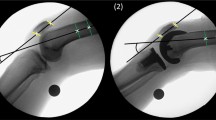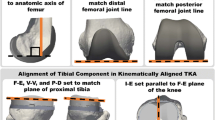Abstract
Purpose
Kinematically aligned (KA) TKA strives to restore native limb and knee alignments without ligament release with the premise that knee function likewise will be closely restored to native to the extent enabled by the components used. This study determined differences in anterior–posterior (AP) tibial contact locations of a KA TKA performed with asymmetric, fixed bearing, posterior cruciate-retaining (PCR) components from those of the native contralateral knee and also determined the incidence of posterior rim contact of the tibial insert during a deep knee bend and a step-up.
Methods
Both knees were imaged using single-plane fluoroscopy for 25 patients with a calipered KA TKA and a native knee in the contralateral limb. AP tibial contact locations in each compartment were determined following 3D model-to-2D image registration. Differences in mean AP tibial contact locations in each compartment between the KA TKA knees and the native contralateral knees were analysed. Contact locations either on or beyond the most posterior point of the tibial insert determined the occurrence of posterior rim contact.
Results
Mean AP tibial contact locations for both native and KA TKA knees remained relatively centred in the medial compartment but moved posterior in the lateral compartment during flexion. In both the medial and lateral compartments, differences in mean AP tibial contact locations between the KA TKA knees and the native contralateral knees were more posterior and greatest at 0° flexion for both activities (4 mm, p = 0.0009 and 7 mm, p < 0.0001 for deep knee bend and 6 mm, p < 0.0001 and 8 mm, p < 0.0001 for step-up in the medial and lateral compartments, respectively). The incidence of posterior rim contact of the tibial insert was 16% (4 of 25 patients) but the lowest Oxford Knee Score was 43 for these patients. The median Oxford Knee Score for all patients was 46 (out of 48).
Conclusions
Calipered KA TKA with asymmetric, fixed bearing, PCR components resulted in mean AP tibial contact locations which were relatively centred in the compartments and differed at most from those of the native contralateral knee by approximately 15% of the AP dimension of a mid-sized tibial baseplate. Although posterior rim contact occurred in some patients, all such patients had high patient-reported outcome scores.
Level of evidence
Therapeutic, Level III.








Similar content being viewed by others
References
Banks SA, Hodge WA (1996) Accurate measurement of three-dimensional knee replacement kinematics using single-plane fluoroscopy. IEEE Trans Biomed Eng 43(6):638–649
Banks SA, Hodge WA (2004) Design and activity dependence of kinematics in fixed and mobile-bearing knee arthroplasties. J Arthroplast 19(7):809–816
Bartlett JW, Frost C (2008) Reliability, repeatability and reproducibility: analysis of measurement errors in continuous variables. Ultrasound Obstet Gynecol 31(4):466–475
Calliess T, Bauer K, Stukenborg-Colsman C, Windhagen H, Budde S, Ettinger M (2017) PSI kinematic versus non-PSI mechanical alignment in total knee arthroplasty: a prospective, randomized study. Knee Surg Sports Traumatol Arthrosc 25(6):1743–1748
Dennis DA, Komistek RD, Colwell CE Jr, Ranawat CS, Scott RD, Thornhill TS, Lapp MA (1998) In vivo anteroposterior femorotibial translation of total knee arthroplasty: a multicenter analysis. Clin Orthop Relat Res 356:47–57
Dossett HG, Estrada NA, Swartz GJ, LeFevre GW, Kwasman BG (2014) A randomised controlled trial of kinematically and mechanically aligned total knee replacements: two-year clinical results. Bone Jt J 96-B(7):907–913
Fregly BJ, Rahman HA, Banks SA (2005) Theoretical accuracy of model-based shape matching for measuring natural knee kinematics with single-plane fluoroscopy. J Biomech Eng 127(4):692–699
Grieco TF, Sharma A, Komistek RD, Cates HE (2016) Single versus multiple-radii cruciate-retaining total knee arthroplasty: an in vivo mobile fluoroscopy study. J Arthroplast 31(3):694–701
Harman MK, Banks SA, Hodge WA (2001) Polyethylene damage and knee kinematics after total knee arthroplasty. Clin Orthop Relat Res 393:383–393
Hess S, Moser LB, Amsler F, Behrend H, Hirschmann MT (2019) Highly variable coronal tibial and femoral alignment in osteoarthritic knees: a systematic review. Knee Surg Sports Traumatol Arthrosc. https://doi.org/10.1007/s00167-00019-05506-00162
Hirschmann MT, Moser LB, Amsler F, Behrend H, Leclerq V, Hess S (2019) Functional knee phenotypes: a novel classification for phenotyping the coronal lower limb alignment based on the native alignment in young non-osteoarthritic patients. Knee Surg Sports Traumatol Arthrosc. https://doi.org/10.1007/s00167-00019-05509-z
Howell SM, Hodapp EE, Vernace JV, Hull ML, Meade TD (2013) Are undesirable contact kinematics minimized after kinematically aligned total knee arthroplasty? An intersurgeon analysis of consecutive patients. Knee Surg Sports Traumatol Arthrosc 21(10):2281–2287
Howell SM, Papadopoulos S, Kuznik KT, Hull ML (2013) Accurate alignment and high function after kinematically aligned TKA performed with generic instruments. Knee Surg Sports Traumatol Arthrosc 21(10):2271–2280
Howell SM, Shelton TJ, Hull ML (2018) Implant survival and function ten years after kinematically aligned total knee arthroplasty. J Arthroplast. https://doi.org/10.1016/j.arth.2018.07.020
Indrayan A (2013) Methods of clinical epidemiology. Springer series on epidemiology and public health, Chap 2. Springer, Berlin. https://doi.org/10.1007/978-3-642-37131-8_2
Li C, Hosseini A, Tsai TY, Kwon YM, Li G (2015) Articular contact kinematics of the knee before and after a cruciate retaining total knee arthroplasty. J Orthop Res 33(3):349–358
Mahfouz MR, Hoff WA, Komistek RD, Dennis DA (2003) A robust method for registration of three-dimensional knee implant models to two-dimensional fluoroscopy images. IEEE Trans Med Imaging 22(12):1561–1574
Matsumoto T, Takayama K, Ishida K, Hayashi S, Hashimoto S, Kuroda R (2017) Radiological and clinical comparison of kinematically versus mechanically aligned total knee arthroplasty. Bone Jt J 99-B(5):640–646
Moglo KE, Shirazi-Adl A (2005) Cruciate coupling and screw-home mechanism in passive knee joint during extension–flexion. J Biomech 38(5):1075–1083
Moro-oka TA, Hamai S, Miura H, Shimoto T, Higaki H, Fregly BJ, Iwamoto Y, Banks SA (2008) Dynamic activity dependence of in vivo normal knee kinematics. J Orthop Res 26(4):428–434
Moro-oka T, Hamai S, Miura H, Shimoto T, Higaki H, Fregly BJ, Iwamoto Y, Banks SA (2007) Can magnetic resonance imaging–derived bone models be used for accurate motion measurement with single-plane three-dimensional shape registration? J Orthop Res 25(7):867–872
Moser LB, Hess S, Amsler F, Behrend H, Hirschmann MT (2019) Native non-osteoarthritic knees have a highly variable coronal alignment: a systematic review. Knee Surg Sports Traumatol Arthrosc. https://doi.org/10.1007/s00167-00019-05417-00162
Nedopil AJ, Howell SM, Hull ML (2016) Does malrotation of the tibial and femoral components compromise function in kinematically aligned total knee arthroplasty? Orthop Clin N Am 47(1):41–50
Nedopil AJ, Singh AK, Howell SM, Hull ML (2018) Does calipered kinematically aligned TKA restore native left to right symmetry of the lower limb and improve function? J Arthroplast 33(2):398–406
Okamoto N, Breslauer L, Hedley AK, Mizuta H, Banks SA (2011) In vivo knee kinematics in patients with bilateral total knee arthroplasty of 2 designs. J Arthroplast 26(6):914–918
Paschos NK, Howell SM, Johnson JM, Mahfouz MR (2017) Can kinematic tibial templates assist the surgeon locating the flexion and extension plane of the knee? Knee 24(5):1006–1015
Prins AH, Kaptein BL, Stoel BC, Reiber JHC, Valstar ER (2010) Detecting femur–insert collisions to improve precision of fluoroscopic knee arthroplasty analysis. J Biomech 43(4):694–700
Rathnayaka K, Momot KI, Noser H, Volp A, Schuetz MA, Sahama T, Schmutz B (2012) Quantification of the accuracy of MRI generated 3D models of long bones compared to CT generated 3D models. Med Eng Phys 34(3):357–363
Ross DS, Howell SM, Hull ML (2017) Errors in calculating anterior–posterior tibial contact locations in total knee arthroplasty using three-dimensional model to two-dimensional image registration in radiographs: an in vitro study of two methods. J Biomech Eng 139(12):121003.121001–121003.121010
Roth JD, Howell SM, Hull ML (2015) Native knee laxities at 0, 45, and 90 of flexion and their relationship to the goal of the gap-balancing alignment method of total knee arthroplasty. J Bone Jt Surg 97-A(20):1678–1684
Roth JD, Howell SM, Hull ML (2018) Kinematically aligned total knee arthroplasty limits high tibial forces, differences in tibial forces between compartments, and abnormal tibial contact kinematics during passive flexion. Knee Surg Sports Traumatol Arthrosc 26(6):1589–1601
Roth JD, Howell SM, Hull ML (2019) Analysis of differences in laxities and neutral positions from native after kinematically aligned TKA using cruciate retaining implants. J Orthop Res 37(2):358–369
Victor J, Banks S, Bellemans J (2005) Kinematics of posterior cruciate ligament-retaining and -substituting total knee arthroplasty: a prospective randomized outcome study. J Bone Jt Surg 87-B(5):646–655
Watanabe T, Ishizuki M, Muneta T, Banks SA (2013) Knee kinematics in anterior cruciate ligament-substituting arthroplasty with or without the posterior cruciate ligament. J Arthroplast 28(4):548–552
Yamaguchi S, Gamada K, Sasho T, Kato H, Sonoda M, Banks SA (2009) In vivo kinematics of anterior cruciate ligament deficient knees during pivot and squat activities. Clin Biomech 24(1):71–76
Acknowledgements
The authors would like to thank the individuals who participated in this study for their contribution to the advancement of education and research. Lastly, the authors would like to thank Savannah Axume Gamero, Anya Guzman, Yash Taneja, and Caitlyn Munch for assistance with segmentation and image processing.
Funding
This study was funded by Zimmer-Biomet, Award number IRU2016-101K:Knees.
Author information
Authors and Affiliations
Corresponding author
Ethics declarations
Conflict of interest
S. M. Howell is a paid consultant for THINK Surgical and Medacta, Inc. M. L. Hull receives research support from Zimmer-Biomet and Medacta, Inc. Remaining authors declare that they have no conflict of interest.
Ethical approval
This study was approved by the University of California Davis Institutional Review Board (IRB#954288).
Additional information
Publisher's Note
Springer Nature remains neutral with regard to jurisdictional claims in published maps and institutional affiliations.
Rights and permissions
About this article
Cite this article
Nicolet-Petersen, S., Saiz, A., Shelton, T. et al. Small differences in tibial contact locations following kinematically aligned TKA from the native contralateral knee. Knee Surg Sports Traumatol Arthrosc 28, 2893–2904 (2020). https://doi.org/10.1007/s00167-019-05658-1
Received:
Accepted:
Published:
Issue Date:
DOI: https://doi.org/10.1007/s00167-019-05658-1




